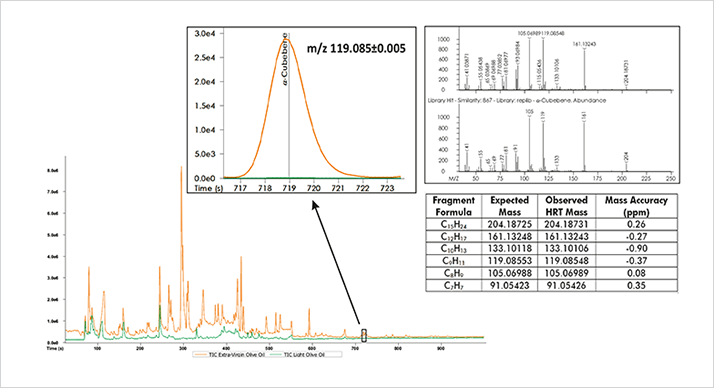Introduction
Characterization of food products, including differential analysis, is important in the food industry for quality control, brand awareness, and authentication of materials and products. GC coupled with high resolution TOFMS isolates individual analytes within complex matrices through both chromatographic and mass spectral resolution and provides confident analyte identifications with industry-leading mass accuracy. These analytical tools were employed for a nontargeted volatile analysis of aroma and flavor analytes in representative extra-virgin and light olive oil samples from a single manufacturer. Automated Peak Finding and sample comparison tools, such as "Reference," within the ChromaTOFHRT® software provide rapid sample characterizations and differentiation to help researchers reliably determine what else is in their sample and if it should be there. These analysis tools were used to highlight and confidently identify differences between the samples which are important in differentiating oil varieties and in determining the source of unanticipated analytes in the samples. These capabilities may also facilitate detection of food fraud by readily distinguishing extra-virgin from light olive oil and other edible oils.


 Figure 1. Representative TIC chromatograms are overlaid for extra-virgin olive oil (orange trace) and light olive oil (green trace) from the same manufacturer. Many analyte differences are apparent and ChromaTOF's Reference feature was utilized to determine analytes unique to each sample with automated processing. α-Cubebene was found in the extra-virgin olive oil and not in the light olive oil. This analyte, indicative of extra-virgin olive in these comparisons, is highlighted with an XIC chromatogram of m/z 119.085±0.005. The deconvoluted and library spectra are shown with a spectral similarity score in the 800s. The accurate mass information adds confidence to this identification with excellent agreement of the expected and observed HRT masses for the molecular ion as well as several fragment ions. The mass accuracies are all below 1 ppm.
Figure 1. Representative TIC chromatograms are overlaid for extra-virgin olive oil (orange trace) and light olive oil (green trace) from the same manufacturer. Many analyte differences are apparent and ChromaTOF's Reference feature was utilized to determine analytes unique to each sample with automated processing. α-Cubebene was found in the extra-virgin olive oil and not in the light olive oil. This analyte, indicative of extra-virgin olive in these comparisons, is highlighted with an XIC chromatogram of m/z 119.085±0.005. The deconvoluted and library spectra are shown with a spectral similarity score in the 800s. The accurate mass information adds confidence to this identification with excellent agreement of the expected and observed HRT masses for the molecular ion as well as several fragment ions. The mass accuracies are all below 1 ppm.Experimental
Samples: Extra virgin and light olive oils from a single manufacturer were analyzed. Two grams of each sample were pipetted into 10 mL SPME vials and sealed with septum caps. HS-SPME conditions: HS-SPME sampling was performed with a divinylbenzene/carboxen/polydimethylsiloxane (50/30 μm DVB/CAR/PDMS, Supelco, Bellefonte, PA, USA) fiber. Each sample was incubated at 40 C for 5 min prior to o 25 min of extraction at the same temperature.





